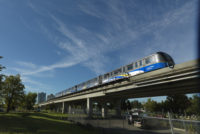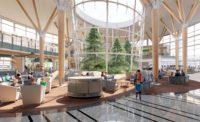Construction of a 700-ft-long footbridge—cantilevered out on 20 steel beams and clinging to the side of a canyon in North Vancouver, British Columbia—has been an adrenaline-pumping building project that, when finished, will leave tourists breathless. Visitors to the Capilano Suspension Bridge & Park will be able to view the surrounding Canadian rainforest from a galvanized steel walkway with a 20-in.-wide timber deck, which is suspended 300 ft above the canyon floor and attached to a granite cliff face up to 20 ft away.
It was difficult to even find a starting point for the design of the unique cliff-hanging attraction, says Kent LaRose, formerly the project’s structural engineer with McElhanney Consulting Services Ltd., Surrey, British Columbia, now with Vancouver’s Morrison Hershfield Ltd. For example, engineering an alignment on 200 vertical ft of rock required examining 12 different options during the process, he says. Nevertheless, despite these challenges, one of the project’s goals was to minimize the bridge’s environmental footprint, which ended up being less than 120 sq ft, LaRose adds.
The concept, developed by John Stibbard, Capilano’s vice president of operations, aims to bring “more thrill to the park,” he says. The $3-million walkway is suspended from steel cables and cantilevered beams to 16 anchor points in the rock. Cliff-hanger construction started in December 2009; now in the project’s final stages, crews are load-testing and installing the super-thin steel-mesh siding. To further augment the park’s network of bridges, stairs and viewing platforms among the 300-year-old Douglas firs, crews are building a 65-ft-long, cable-supported curved bridge, seven straight bridge segments, nine sets of stairs and seven platform areas.
The first step in determining how to build the system was to send surveyors rappelling down the cliff to develop coordinates for foundation points, LaRose says. The final configuration takes visitors well above falling-rock hazards, as recommended by Duncan Wyllie, a geotechnical engineer with Vancouver-based Wyllie & Norrish Rock Engineers.
The survey data was transferred into a 3D digital model to accurately place the steel anchor plates and the foundation before steel fabrication started. “It was a constant process of taking measurements in the field and communicating those in 3D to the fabricators,” says Mark Frew, structural division manager at McElhanney.
LaRose says the site constraints drove the design. For instance, all 1,500 ft of steel was lowered in place over the trees by a small crane. All the workers needed rappelling skills, and they had to side step parts of the rocks covered in fern and moss, large trees and weak rock.
To anchor the walkways, four foundations consist of cast-in-place concrete, while other foundations have steel beams anchored to steel plates drilled directly into the rock as deep as 16 ft.; there are also two foundations on soil using mini-piles. The connection design of the steel anchor plates allows the lightweight, cable-supported cantilevered beams, which are attached to the rock face, freedom to rotate horizontally. “Everything had to be really flexible in the final orientation in the horizontal plane to allow for typical construction tolerances,” LaRose says.
Sometimes a designed foundation point produced weak rock once drilling started, requiring the team to rework the design on the fly. “We couldn’t change where the platforms and bridges were,” LaRose says. “We had to change the configuration of beams horizontally so that [the bridge] had a deflection at mid-length, and then [we had to] fabricate the beam to suit the walkway geometry.”
The majority of the pieces fabricated by Surrey-based Solid Rock Steel Fabricating Co. had, at most, 5-millimeter tolerances, to fit the location of the anchor plates as surveyed on the rocks.
Wyllie says the rock bolts, ranging in length from 10 to 16 ft, also reinforce the rock face to prevent spalling. “Every rock bolt has been tested to ensure that it can support at least 125% of the load applied to the structure,” Wyllie says. Each bolt was installed using handheld equipment because of the site requirements.
The walkway itself, built by Marc Luc Construction, the Kootenays, British Columbia, starts from a spiral staircase connected to the eastern part of the main suspension bridge. Along the way, two glass platforms with a baked-ceramic finish invite visitors to step off the narrow, one-way bridge for an even bigger “wow” factor. As sightseers will be able to see the canyon floor on either side of the narrow walkway, only the two platforms were made of glass, minimizing the fear factor, LaRose says. Furthermore, rather than having a bridge with some sort of glass bottom, the timber deck will be easier to maintain in a park that receives 200 days of rainfall each year.
The geometry surrounding the 20-ft attachments wasn’t easy, either, LaRose says. Limited machine access forced five field splices, and one crane required the bridge at all times to be self-supporting with temporary horizontal bracing. Since the cable supports are high on the rock, the nine cables are draped at a shallow angle to give “significant horizontal force,” says LaRose.








Post a comment to this article
Report Abusive Comment